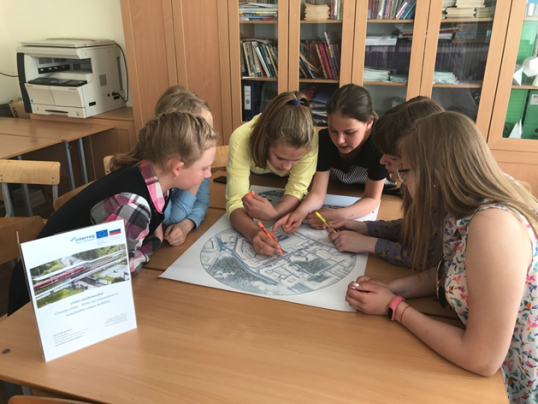- Topic
- Mobility management
- Walking and cycling
- Resource type
- Case study
First published on 14 July 2020.
To assess the current needs of children in the city of Pskov a masterclass for children and adolescents was organised by the Pskov city administration and the International Centre for Social and Economic Research (ICSER) Leontief Centre in St Petersburg.
This case study has been created as a part of the cities.multimodal project.
In accordance with the goals set within the framework of the master class, the following objectives were set:
- Analysis of the state of the infrastructure for children.
- Identification of the main hazards (overt and latent) and opportunities.
- Identification the most pressing problems of parents and children in the city of Pskov.
- Analysis of the basic needs of adolescents.
The target group of the master class was schoolchildren in the ages 8-12 years old and adolescents from 13-17 years old. The size of the group was around 40-48 participants.
Context
A child-friendly city is one in which children and teenagers can fully develop, actively participate in the public life of the city and take part in the decision-making that affects their interests. In a child-friendly city, local executive bodies, institutions, children's and youth associations, and residents make efforts to achieve the rights of children as contained in the UN Convention on the Rights of the Child. In such a city, the opinion of children is taken into account when developing local development programs.
In action
The research area of the Pskov a masterclass for children and adolescents was the historical area of Pskov.
Part 1: Preparation
A survey (questionnaires for schoolchildren aged 8-12 years old and 13-17 years old) was completed for giving a general portrait of the participants (age, gender, etc.) and focal points for children and adolescents in the studied area.
Part 2: Area Mapping
Participants were asked to map specific places in the historic center, including;
- Their favorite places to walk.
- The barriers to being able to walk.
- Their most popular routes.
The survey allowed researchers to draw a mental map of the historical center of the city helping them to understand how schoolchildren represent and understand barriers and how they affect them, divisions between favorite places and dangerous spots as well as how do they create their own routes for moving in the city.
Part 3: Investigation
After drawing up a mental map, teams of participants, accompanied by experts went to the local area for a detailed study of the urban environment. The participants identified problem areas and attractive areas, for example: where the paths are uneven, where poles, cars, and advertising make it difficult to walk or ride comfortably, where there is no pavement at all and you must walk or cycle along the roadway, where there are lighting and ramps and where children can cut the road to get to school.
To study the places where children play, discussions were held to find out how schoolchildren assess the space in which they live and play, and how they would prefer it to be.
Results
Urban spaces and infrastructure that is designed without considering the opinion of children could eventually lead to a city in which children have no place.
Participation, or involving children in urban and mobility planning, and building partnerships between different communities and organisations will help make more informed and effective decisions. Children and those who look after them (parents, relatives, babysitters, caregivers and teachers) have a unique knowledge of their area, dangerous and safe places, as well as where changes and improvements should be made, first. Projects created jointly have an indisputable advantage - the participants have a feeling of belonging and responsibility, vandalism is reduced, and new social ties are emerging.
Challenges, opportunities and transferability
Holding the master class facilitates finding solutions based on existing user experience.
Of course, the architect and the master planner know how to design the urban space, but they may not consider spontaneous parking, fast or slow cars, or using a shortcut through or across common land. This is called user experience and understanding the user experience is necessary to create a comfortable urban environment for younger people.
The results of the master class are conveyed to the architect in the form of technical specifications and wishes from the participants.
In Depth
This case study was created as a part of the cities.multimodal project and based on a report by: pskovcbc mail [dot] ru (Kristina Kobyz) Head of the Committee of Cross-border Cooperation and Tourism Pskov city Administration and olga [dot] iakimenko
mail [dot] ru (Kristina Kobyz) Head of the Committee of Cross-border Cooperation and Tourism Pskov city Administration and olga [dot] iakimenko yandex [dot] ru (Olga Iakimenko) Expert of ICSER Leontief Centre.
yandex [dot] ru (Olga Iakimenko) Expert of ICSER Leontief Centre.
This case study has been prepared for the European Commission however it reflects the views only of the authors, and the European Commission is not liable for any consequence stemming from the reuse of this publication.

